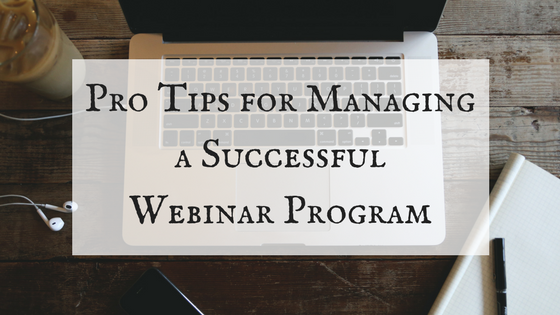
Pro Tips for Managing a Successful Webinar Program
People are attracted to webinars because they offer educational insight into an industry. They have become one of the most well-used forms of lead generation today and more companies are beginning to see the benefit of producing them.
Like any event, webinars take a certain level of preparation; schedule a date and time, pick a topic and presenters, promote. Check, check and check. Learning how to run a webinar is the easy part. Fully understanding that your job takes more than that is where the challenge begins. Today I’m sharing a few things I’ve learned along the way.
Does the content pass your inspection
The very first point I want to make is this; don’t be afraid suggest changes to your client. You are the last person to see the content before it’s sent to your audience and it’s your job to grow the registration. You know what will work. When creating or reviewing content ask yourself if it will be well received and if it will be interesting.
More often than not, you don’t have the same technical background as your audience so it’s important to understand their technology.
Know your audience behavior
The day and time of your webinar is the second most important aspect of hosting a successful webinar. Industry standard across the board recommends hosting webinars mid-week. However, that doesn’t mean Monday and Friday won’t perform well from time to time. If you are unsure what days work best, check out Google Analytics to see what days of the week have the most traffic. Make sure to do this month-to-month as it may vary.
As for the time, 2:00p.m. EST tends to be the “sweet spot” because it encompasses all time-zones. Again, if you are unsure when to schedule, think about your target audience. Obviously if you only target folks from a certain region, time-zones won’t matter but for many your reach is a lot broader. Using a webinar system, like ON24 or GoToWebinar that allows for recording and on demand options helps combat the timing issue.
Webinars take weeks to plan and execute
A common misconception about webinars is that they can be put together quickly when in reality you need quite a bit of time to produce. A lot of back and forth communication happens in the planning stage of a webinar. Dates have to be set. Presenters have to agree to speak. Content has to be written. Promotion has to be created and go through the approval process. Deadlines have to be met. Dates may be pushed back. On and on and on. All of this takes time.
I typically require six weeks from start to finish. How long does it take you to reach a lead goal? Statistically 31% of people register the week before a webinar, but think about the other 69%? At the end of the day, the success of a webinar falls on you, allow the cushion.
Keep everything in one place
A successful webinar producer is highly organized. Repeat. Highly Organized. This job is not for the lazy employee. Each webinar has its own collection of moving parts, all in various stages and chances are you are not the only person involved. Whether its account managers, clients or your boss someone will always ask for an update or link.
Keep of master spreadsheet with all the information about a webinar. Use a system that works best for your style. Most common inquiries include:
- Lead Goal, Cost of Webinar and Client Contact
- Date of the live event deadlines and meetings
- Links to promotion and dates of deployment
- Registration Status
- Ongoing Notes
- Archived Links
Get into the habit of updating the status every day, sometimes twice depending on when promotion is scheduled. Use a system that works for you.
What pro tips do you have? Comment below and keep the conversation going.



Leave a Comment
You must be logged in to post a comment.